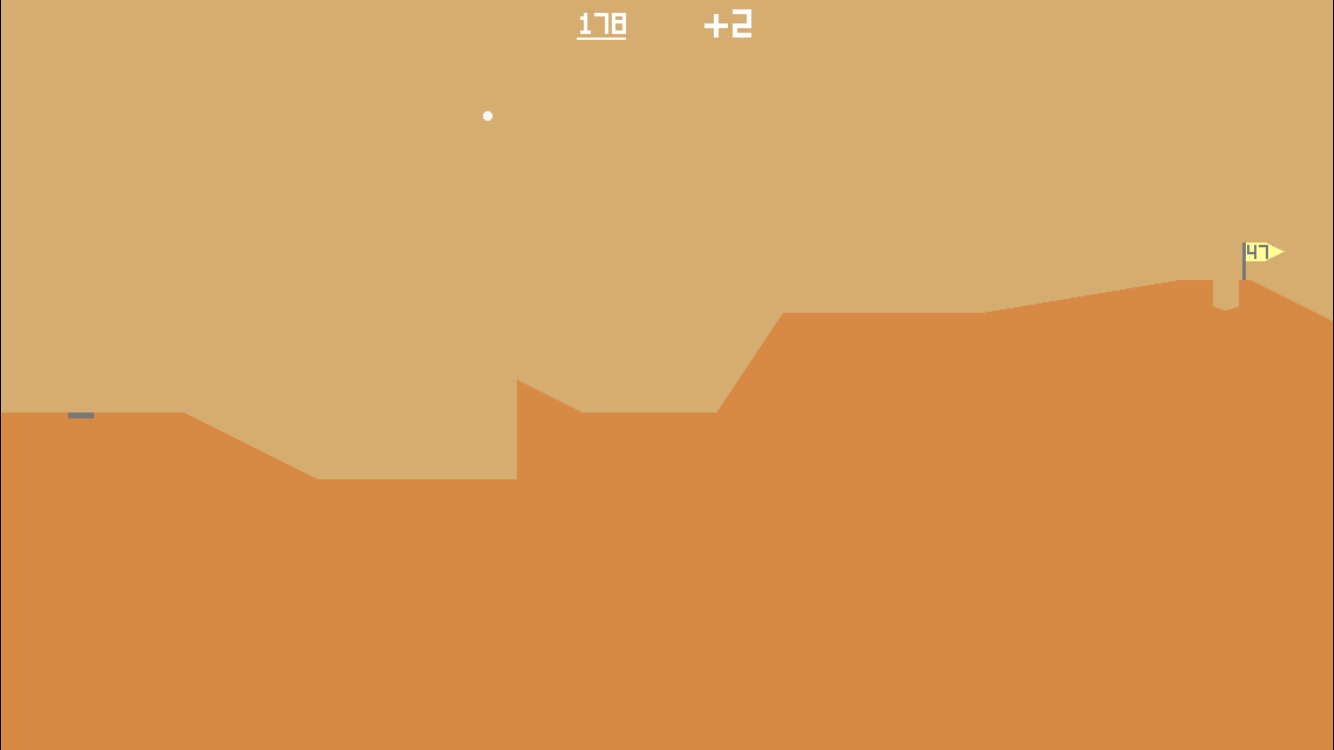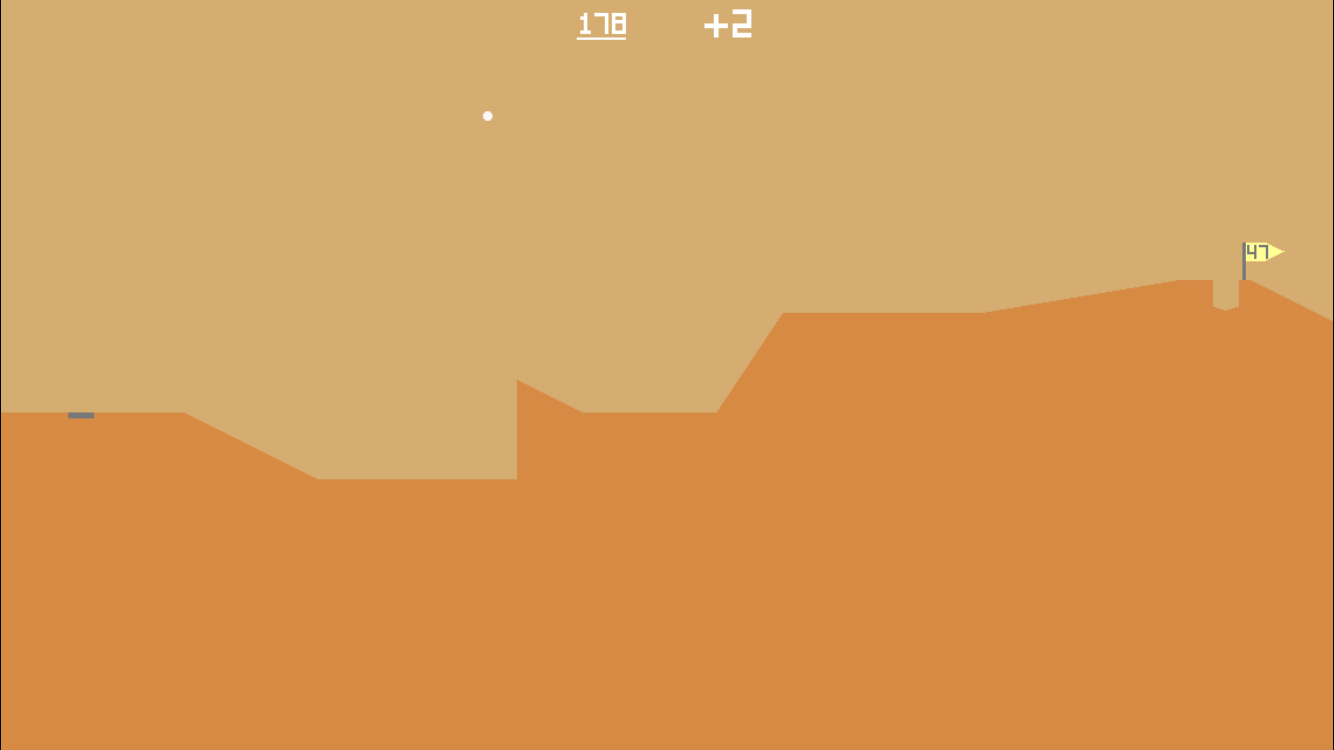
Desert Golfing, a game you can purchase for your iOS or Android device, is perfectly designed for its environment. Right now, no other video game better harnesses the always-on-and-always-aimless nature of pocket computers. It’s a game full of goals, but those objectives originate from the player as much as the game’s creator. If there’s one phrase I associate with smartphones, it’s “killing time”. I don’t know if there were fewer moments of boredom in the past, or if we only started to notice the five minute gaps in our day after everybody stopped smoking cigarettes, but since smartphones came around we’ve all gotten very good at filling in the temporal cracks. I don’t remember killing time as a child. I remember doing a whole lot of nothing, but I never felt like I was actively trying to fritter any moment away. That’s probably because I rarely had anywhere to be, so there was never space between appointments. It’s a lie to say that I did nothing as a kid, what I actually did was construct meaningless games in my head. My door became a dartboard, my dresser became a warzone, my backyard became a golf course. These games lacked time limits, and because they existed in my mind, I could visit them whenever I wanted, for as long as was available. Desert Golfing is like one of the imaginary games I played as a kid, except it puts my backyard inside my pocket.

Most games establish winners and losers. The most popular games on phones are score based challenges like Angry Birds. In that game, each level has a par score that earns you stars that facilitate progression to more levels. At some point in the game’s development, a designer sat down and decided how good players needed to be in order to progress. That sort of judgement pervades the App Store. In my favorite iOS game, Tiny Wings, you race against the clock to achieve a high score. Every game of Tiny Wings will end, no matter how well you play. Your goal is to extend the amount of time the creator allows you to enjoy the game. There’s nothing wrong with game scores, they let you compare your performance against other people. The fact is, however, that most people don’t compare their scores with others. While things like Apple’s Game Center envision a world where people are locked in constant electronic competition, the reality is that we’re all playing solitare. If that’s the case, there’s no reason to play games on anyone’s terms but your own. It’s silly to realize that you’ve got to play a particularly irritating level in Angry Birds again because you didn’t beat it well enough the first time, and it’s frustrating to leave Tiny Wings mid-run because your excellent performance prolonged the game beyond the length of your bus ride. These are games that happen to be on phones, but they don’t play in ways that fit how I use my phone. I used to get irritated when developers would slap lackluster facsimiles of traditional game controllers on top of a touchscreen game and call it a day. I’m starting to get that same irritation with games that force me to select levels, or games that feature a certain mandatory play time. I do not dedicate time out of my day to play games on my phone, I play games on my phone when I want to fill in the gaps in my schedule. This means that games are in competition with a web browser that can give me instantaneous access to endless distractions. I do not want to play a game that demands my time, I want to play a game that uses my time wisely. Desert Golfing is that game. It’s literally endless, and the start up time is nonexistent. There is no start screen in this game, no menu to futz with, and no music to distract from the podcast playing in your headphones. There’s only a desert, and that desert is infinite. The first screen in Desert Golfing looks exactly like every other screen in the game. There’s a golf ball on the left side of the display and a hole on the right. You hit the golf ball by sliding your finger anywhere on the screen. There are no other controls. Once you get the ball into the hole, the hole rises up to meet the desert surface and becomes the next tee, while the screen scrolls over to reveal a new hole in the distance. The landscape is randomly generated, a continuous jagged expanse that provides varying degrees of challenge. Whenever you open Desert Golfing, the game is instantly right where you left it. It is a physical place that hides inside a computer. The genius of Desert Golfing manifests in its score counter, which simply tallies up your total strokes across all the holes you play. The game doesn’t provide pars for the holes, and you can’t reset the counter. This means you’ll set goals for yourself. Each of the holes can be completed in one shot, but only a masochist would hold themselves to that standard. Instead, I play this game as a series of bets with myself. “I’ll bet I can do that in three,” I’ll mutter, though inevitably I’ll revise that estimate as the strokes add up. It’s fun to set my own goals, particularly given that any goal that the game provided would be equally arbitrary. Because the game only features one mechanic, it doesn’t matter that you can’t go back and play levels over again. You’re never practicing a level in Desert Golfing, you’re practicing how to be a better golfer on any hole you play in the future.

If someone asked me why they should play Desert Golfing, I’d say, “Because it’s there!” Indeed, this is more of a digital location that lets you blow off steam than a string of objectives that must be attained. You can play it as a race to complete holes as quickly as possible, or you can just delight in the physics of bouncing the ball off of the sand. It is waiting for you whenever you want to visit, and it can be shoehorned into any idle moment. It’s the best way to eat up your spare seconds without feeling like someone else took that time from you. It is a perfect mobile video game. ★
This article originally appeared on Medium on October 10, 2014.